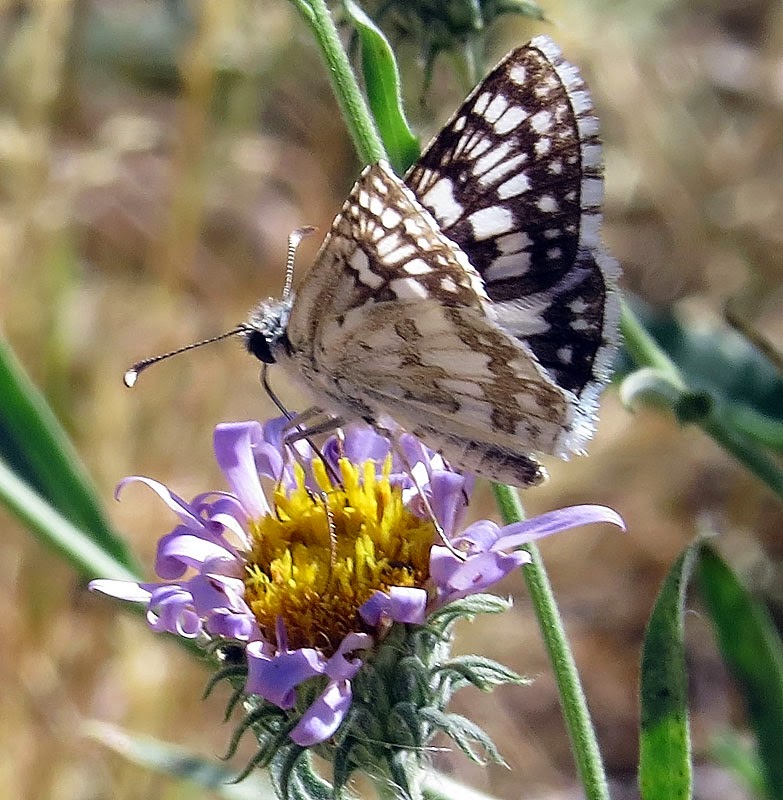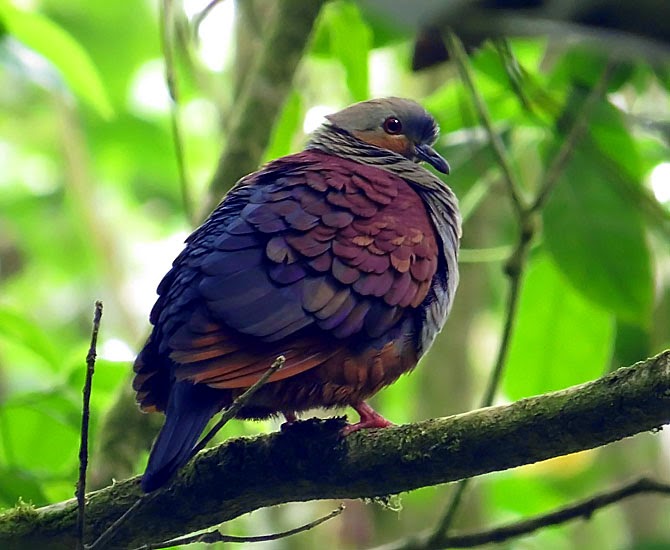Our second
full day of birding in Jamaica was nearly perfect, a ideal day of sublime
birding, one amazing bird sighting after another, mixed with odd plants,
vertebrates, and invertebrates, many also endemic.
I can barely
imagine a more enjoyable day of birding for my clients. I had gotten up extra
early, prepared a scrambled egg, toast, and cereal breakfast for them so we
could be out in the good habitat at dawn (and our housekeepers had prepared
fruit plates the evening before), and by noon we had seen 22 of the island’s 27
endemics, most of them extremely well. Just the evening before, after some
effort, we had amazing views of a Jamaican Owl and earlier that day we had perfect
views of this Jamaican Lizard-Cuckoo with no help from my iPod.
That meant by
lunchtime this day, which was a delightful preparation by our housekeepers (and
I had to order it from home several days in advance), we had seen (SEEN!) 24 of
Jamaica’s 27 endemic birds.
We had views
of a perched Ring-tailed Pigeon. We hadn’t yet had our best views of Crested
Quail-Dove (see my previous blog), but everyone had countable views. A
Chestnut-bellied Cuckoo was very obliging, and if the Jamaican Mangos weren’t
satisfactory, one was at the feeders at our lodge, and the same could be said
of the Black-billed Streamertails. We saw several Jamaican Todies, some at a
ridiculously close range, like this one.
We had seen Jamaican
Woodpecker the day before, but today we had spectacular views. Black-billed and
Yellow-billed Parrots perched for scope views, Jamaican Elaenia responded to
playback like nothing else existed, and this Sad Flycatcher was almost close
enough to touch.
We got our
best views of Rufous-tailed Flycatcher, saw Jamaican Vireo well enough to
count, and enjoyed the oddness of a Blue Mountain Vireo. Jamaican Crow called
here and there and flew by well enough to see that it was indeed a crow, and we
even saw the white chin on White-chinned Thrushes. The strange Orangequit was
everywhere, the monotypic genus of Yellow-shouldered Grassquit couldn’t have
performed better, Jamaican Spindalis was hard to avoid, Jamaican Blackbird was
easier than usual, and Jamaican Euphonia showed up here and there with no
effort.
So what kept
this day from the absolute pinnacle of perfection? After all, how can you top
seeing 24 amazing endemics in 24 hours, all lifers for everyone except for me
and my co-leader Ann Sutton? And we even had heard a 25th endemic
superbly, the White-chinned Thrush, which has a marvelously musical voice superseding
its own appearance by any measure. There were only two endemics we hadn’t seen
or heard, and to be sure I was keeping track, and we still had FIVE more days
on the island. I had worked hard and enjoyed showing these all to my clients;
after all, I had developed a personal relationship with all of these species
over the past 16 years. So what kept this from being the most perfect birding
day ever?
It came at
about 3:45 p.m. when one participant asked, “So, what are our chances that
we’ll see Jamaican Pewee?” I found that question more than just annoying,
though I simply and pointedly responded by saying just that. A happy and
thoughtful person should have been still swooning over just that one Jamaican
Tody, or even more so over the Jamaican Lizard-Cuckoo we saw as it pried apart
clusters of dead leaves right over the road. And I’m certain most of the
participants were doing just that. I was fully aware we hadn’t seen Jamaican
Becard, White-eyed Thrush, or Jamaican Pewee, for that is my job, and I always want
my clients to see everything. I was also aware that most people needed better
view of Jamaican Vireo and Arrowhead Warbler, and we hadn’t yet seen a Jamaican
Crow perched, for example. But who in their right mind would have been thinking
about those misses after all we had seen? Isn’t it fair to assume that our
chances for seeing any more endemics were as good as they’ll ever be, given
that that’s my job, and I was currently doing it nearly 12 hours a day and we
had five days left? Besides, is there really an answer to that question that
makes any sense? Of course with birds, it’s never 100%, so was she honestly
hoping for answer like 91.29% or 88.4%? Since there obviously isn’t a correct answer
to that question, I instantly regarded it as a rhetorical and offensive criticism
of my effort and abilities. I saw it as an indication that everything I had
done this day, starting with getting up extra early to make breakfast had been
a complete failure and that nothing we had seen that day counted towards
anything. But of course only after I thought about it for some time did I
conclude that it wasn’t meant to be that, and didn’t reflect on me at all – it
reflected only on that one person’s mindless goal of getting all of the
endemics and a persistent internal state of dissatisfaction and unhappiness. I
can’t change that in anyone, but then why not a more thoughtful and less
critical way of asking that question, such as “is the Ecclesdown Road the only
place we had a chance for Jamaican Pewee, or might we see it later in the tour
as well?”
It’s
impossible for me to not be preachy at this point, and maybe I’ll encourage
people to be happy if I vent just a little. There are anywhere from 10,000 to
15,000 species of birds on this planet. No one will ever see them all. If your
goal when traveling somewhere is just to see all of the birds, you will probably fail, and
why would you want that? I’m not against listing, and in fact I encourage it –
it takes you to interesting places, and it’s a great portal for learning about
bird biogeography, behavior, genetics, and identification – as long as the list
isn’t your only goal. My career is a joy only as I share others’ delight in
discovering the amazing birds we see on my tours. But if their one and only
goal is to see them all, to miss nothing, then they are setting themselves up –
and me as well – for disappointment, and at the same time they’re not really
able to enjoy the birds they’re seeing each step along the way, for worrying
about missing the next one is always there. I try to not market my tours as
those on which you see every endemic, every specialty. Except for that first
tour in 1999, when we only heard Crested Quail-Dove, I have never missed an
endemic species in Jamaica (though don’t tell anyone that, nor the fact that I
showed Joe Thompson all 27 endemics in just over 12 hours one day a few years
ago). If the Greater Antillean Elaenia gets split, we’ll certainly miss that
endemic from time to time, though I’ve now seen it three years in a row. And
sometimes we get just one Bahama Mockingbird or just brief views of
Rufous-throated Solitaire, both of which could be split and become island
endemics. There’s no sign that Jamaican Blackbird is getting any more common
(and it’s probably the scarcest endemic and the pickiest when it comes to needing
very good habitat), and on some tours I’ve come close to missing Jamaican
Lizard-Cuckoo. So it will happen.
But I don’t
want to stress getting all the endemics, because I don’t want people to have
that nagging worry instead of having fun. Enjoy what you’re seeing in the
moment and let me worry about missing birds. No matter what, we’ll see some
spectacular birds, including some common birds performing spectacular
behaviors, and we see some pretty amazing moths, butterflies, fish, reptiles, amphibians,
miscellaneous invertebrates, and maybe even some mammals.
So I fumed
(mostly internally) for the next day or so, but then we saw the pewee, had
amazing views of a Rufous-throated Solitaire feeding on berries below eye
level, and had the mind-blowing looks at Crested Quail-Dove; and that one
unhappy moment dwindled in importance. We eventually had superb views of
White-eyed Thrush, had plenty of Jamaican Becards building nests, even saw the
crows perched and even better views of Black-billed Parrots. Though I added no
new bird species to my island list, I still enjoyed showing them to people for
whom almost everything was new, and who will probably never get a chance to see
them again. Besides, you can never see too many Jamaican Todies, and we saw
some every day of the tour. I also still delighted in learning more about
Jamaica’s natural history, including plants and bugs. I actually knew the name
of this Eburia tetrastalacta long
horned beetle after lunch on our first day (though most participants wouldn’t
even get out of their chair to come see it, sigh), since I had seen it every
year so far that I have been paying attention to beetles in Jamaica.

But then at
lunch two days later everyone got to see this longhorn, a new one for me, Elaphidion spinicorne. Though not an
island endemic, it’s apparently a Greater Antillean specialty. Many thanks to
the folks who created the New World Cerambycidae Catalog.
There were
several interesting moths at Starlight Chalet this time, and this spectacular
endemic Jamaican Wasp Moth, Horama grotei,
was my favorite find.
This erebid Eulepidotis modestula isn’t endemic, but
it’s one of the prettiest of this genus I’ve seen. It looks extremely similar
to photos of Eulepidotis micca, known as a vagrant in Texas, and
I suspect there might be some confusion there.
This is Epimecis scolopaiae, probably one of the
largest members of this geometrid genus (with something like 44 species) and a
Greater Antillean endemic as well. As far as I can tell, there are no live
photos of this species online.
Also new for
the internet as a live bug is this noctuid Bryolymnia
floccifera, apparently a Jamaican endemic. "Bryo" refers to moss, but I don't know what "lymnia" means, unless it's related to "limn," perhaps in the sense of "highlight." And "floccifera" means bearing woolly tufts.
I had
photographed this little geometer once before, and with more specimen photos of
similar species available online, I’ve decided this is probably Semaeopus callichroa, found in Jamaica
and Cuba, and represented online only by a 90-year-old illustration.

One last
photo is of this Aegisthus Swallowtail Moth that one of my participants spotted
on a window at Marshall’s Pen. I’ve seen it once or twice in the past, but I’m
still a bit uncertain what to call it. Almost all lists now use Sematura as the valid genus, but there is
an undecided three-year-old case before the International Commission on
Zoological Nomenclature that admits that Mania
has priority but should be dropped for the simple reason that Sematura has been used for so long. Further
confusing the issue is name Nothus,
which is even older than those two names and is still used by several
authoritative-looking websites (such as the London Natural History Musem); but since it was used for a beetle first it is
clearly invalid for a moth. But for now it’s looking like Mania aegisthus is the best name.

































































